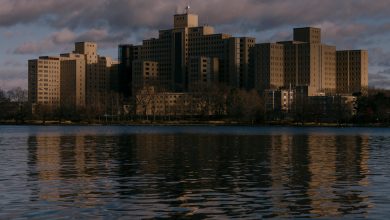Reaching Closer to Earth’s Core, One Lava Scoop at a Time

What do you do when a volcano erupts for the first time in centuries?
For many people on the southern peninsula in Iceland, when the Fagradalsfjall volcano went off in 2021 after 781 years of dormancy, the answer was to take pictures. As the eruption continued over the course of six months, tourists and locals traveled closer to the volcano to take even more. Red bursts flying out of a black pyramid; the viscous creep of flame.
But this documentation only went so far. Some scientists wanted to know what was going on underneath the surface, miles deep, where light does not reach. There, the flowing rock works in ways that experts still cannot describe. So on the first day of the eruption, a helicopter flew out to the site and scooped up a bit of lava. Some samples were distributed to labs, which, after testing, sent back unexpected results: The lava was full of crystals.
Recently, with the help of similar samples gathered throughout the Fagradalsfjall eruption, steps have been taken toward characterizing the dynamics under the surface of the oceanic volcano. In a paper published in June in the journal Nature Communications, researchers who observed the chemical composition of the lava crystal samples collected over a six-month period found that they contained a wide range of material from different parts of the mantle, the amalgamate layer between the Earth’s crust and core. This kind of variation was unexpected, and it painted a more vivid picture of what contributes to volcanic eruptions.
“We have a really detailed record of the different types of composition that we can find in the mantle now, and it must be very heterogeneous, very variable,” said Frances Deegan, a volcanologist at Uppsala University in Sweden, and a co-author of the paper.

Dr. Marshall collected samples of lava and placed them in a small pot of water to prevent the crystallization of the lava and create a homogenous black quenched glass. Video by Maja Rasmussen
Compositionally, the Fagradalsfjall lava was primitive, meaning it came from a deep reservoir of magma, or underground lava, not a shallow reservoir in the Earth’s crust. Noticing this, researchers, including Ed Marshall, a geochemist at the University of Iceland, sprinted to gather more samples as the lava continued to spew out of vents. “We were working all hours — you’re asleep and the volcano’s still erupting and you’re like, ‘I got to get back out there,’” said Dr. Marshall. “But it’s hard to describe how rare this kind of thing is.”
Fagradalsfjall exists at a confluence of fault lines along a boundary between the Eurasian and North American tectonic plates, a point where they are both pulling apart and rubbing against each other. Geological records show that there has been periodic volcanic activity in the region about every thousand years, and this most recent fissure was preceded by more than a year of earthquakes. Olafur Flovenz, director of the Iceland GeoSurvey, recently published a paper with colleagues that suggests this activity was not caused by a body of magma accumulating in the crust, but from carbon dioxide released by deeper magma pooling between the mantle and the crust, in a region called the Mohorovicic discontinuity, or moho.
Usually, volcanic eruptions occur when lots of small magma flows mix together. “This mixing process is an essential geologic process, but it’s never been directly observed,” said Dr. Marshall. It occurs so deep under the surface and many of the chemical signatures of individual flows are lost as the magma moves up through the crust. But when Fagradalsfjall erupted in 2021, the molten rock and crystals that shot up to the surface came directly from the moho. “For the first time, more or less, we are looking at an active eruption on our oceanic crust where the lava is directly erupting from the mantle source,” Dr. Flovenz said.

People watched and recorded lava flows from the Fagradalsfjall volcano when it erupted after 781 years of dormancy on the Reykjanes Peninsula in southwestern Iceland.Credit…Miguel Morenatti/Associated Press
Compared to other oceanic volcanoes, Fagradalsfjall’s vents were relatively easy to access, and its 2021 eruption was fairly tame. Researchers like Dr. Marshall, who did not contribute to either paper but has a forthcoming article on the same subject with a group of collaborators at the University of Iceland, say these studies could essentially reach right into the mantle and capture otherwise hidden dynamic processes “like lightning in a bottle.”
Dr. Deegan and her collaborator, Ilya Bindeman, a geochemist at the University of Oregon, worked with other researchers on the ground at Fagradalsfjall to analyze the lava. They found that not only were the chemicals incredibly varied over time, suggesting that many different parts of the mantle had combined in the eruption, but also that the oxygen isotopes were virtually identical across these samples. This contributes to a long standing technical inquiry into the source of Iceland’s mysteriously low levels of oxygen-18, an isotope often found in volcanic rock. Dr. Bindeman said that scientists have been debating for more than half a century whether this can be attributed to a lack of the isotope in the mantle. “We found that the depletion happens somewhere else,” he said.
Dr. Marshall and his colleagues have also been using the lava samples to describe mixing and melting processes in magma reservoirs, which was not done in the most recent paper.
“These are very exciting times,” said Dr. Flovenz, who started studying Icelandic volcanoes in 1973. “I had never had the hope that I would live to see this unrest and eruptions on this peninsula. This has been extremely interesting for the geosciences community.”
“It’s an absolutely amazing eruption for our field,” said Dr. Marshall, “and it’s one of those things that will be studied for a long time.”

Some of the volcanic jets from the vent of Fagradalsfjall reached as high as 1,400 feet. Video by Edward W. Marshall





